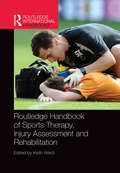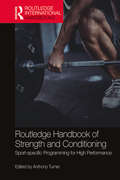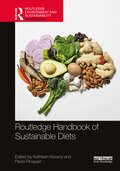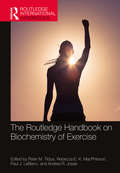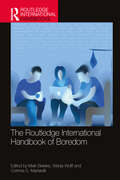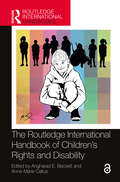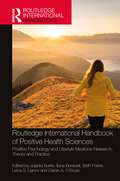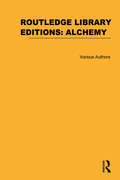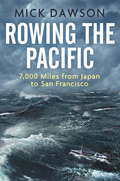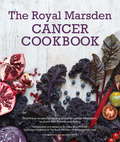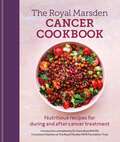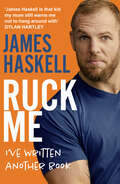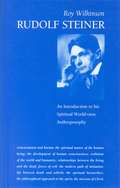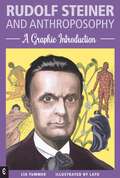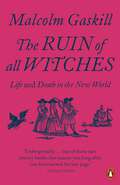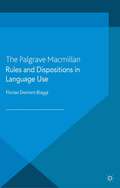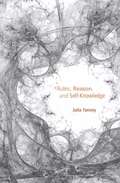- Table View
- List View
Routledge Handbook of Sports Therapy, Injury Assessment and Rehabilitation (Routledge International Handbooks)
by Keith WardThe work of a sports therapist is highly technical and requires a confident, responsible and professional approach. The Routledge Handbook of Sports Therapy, Injury Assessment and Rehabilitation is a comprehensive and authoritative reference for those studying or working in this field and is the first book to comprehensively cover all of the following areas: Sports Injury Aetiology Soft Tissue Injury Healing Clinical Assessment in Sports Therapy Clinical Interventions in Sports Therapy Spinal and Peripheral Anatomy, Injury Assessment and Management Pitch-side Trauma Care Professionalism and Ethics in Sports Therapy The Handbook presents principles which form the foundation of the profession and incorporates a set of spinal and peripheral regional chapters which detail functional anatomy, the injuries common to those regions, and evidence-based assessment and management approaches. Its design incorporates numerous photographs, figures, tables, practitioner tips and detailed sample Patient Record Forms. This book is comprehensively referenced and multi-authored, and is essential to anyone involved in sports therapy, from their first year as an undergraduate, to those currently in professional practice.
Routledge Handbook of Sports Therapy, Injury Assessment and Rehabilitation (Routledge International Handbooks)
by Keith WardThe work of a sports therapist is highly technical and requires a confident, responsible and professional approach. The Routledge Handbook of Sports Therapy, Injury Assessment and Rehabilitation is a comprehensive and authoritative reference for those studying or working in this field and is the first book to comprehensively cover all of the following areas: Sports Injury Aetiology Soft Tissue Injury Healing Clinical Assessment in Sports Therapy Clinical Interventions in Sports Therapy Spinal and Peripheral Anatomy, Injury Assessment and Management Pitch-side Trauma Care Professionalism and Ethics in Sports Therapy The Handbook presents principles which form the foundation of the profession and incorporates a set of spinal and peripheral regional chapters which detail functional anatomy, the injuries common to those regions, and evidence-based assessment and management approaches. Its design incorporates numerous photographs, figures, tables, practitioner tips and detailed sample Patient Record Forms. This book is comprehensively referenced and multi-authored, and is essential to anyone involved in sports therapy, from their first year as an undergraduate, to those currently in professional practice.
Routledge Handbook of Strength and Conditioning: Sport-specific Programming for High Performance (Routledge International Handbooks)
by Anthony TurnerDrawing on the latest scientific research, this handbook introduces the essentials of sport-specific strength and conditioning programme design for over 30 different sports. Enhanced by extensive illustrations and contributions from more than 70 world-leading experts, its chapters present evidence-based best practice for sports including football, rugby, tennis, hockey, basketball, rowing, boxing, golf, swimming, cycling and weightlifting, as well as a variety of wheelchair sports. Every chapter introduces the fundamental requirements of a particular sport – such as the physiological and biomechanical demands on the athlete – and describes a sport-specific fitness testing battery and exercise programme. Additional chapters cover the adaptation of programme design for special populations, including female athletes, young athletes and athletes with a disability. Drawing on the experiences of Olympic and Paralympic coaches and trainers, it offers original insights and practical advice from practitioners working at the highest level. Innovative, comprehensive and truly international in scope, the Routledge Handbook of Strength and Conditioning is vital reading for all strength and conditioning students and an invaluable reference for strength and conditioning coaches and trainers.
Routledge Handbook of Strength and Conditioning: Sport-specific Programming for High Performance (Routledge International Handbooks)
by Anthony TurnerDrawing on the latest scientific research, this handbook introduces the essentials of sport-specific strength and conditioning programme design for over 30 different sports. Enhanced by extensive illustrations and contributions from more than 70 world-leading experts, its chapters present evidence-based best practice for sports including football, rugby, tennis, hockey, basketball, rowing, boxing, golf, swimming, cycling and weightlifting, as well as a variety of wheelchair sports. Every chapter introduces the fundamental requirements of a particular sport – such as the physiological and biomechanical demands on the athlete – and describes a sport-specific fitness testing battery and exercise programme. Additional chapters cover the adaptation of programme design for special populations, including female athletes, young athletes and athletes with a disability. Drawing on the experiences of Olympic and Paralympic coaches and trainers, it offers original insights and practical advice from practitioners working at the highest level. Innovative, comprehensive and truly international in scope, the Routledge Handbook of Strength and Conditioning is vital reading for all strength and conditioning students and an invaluable reference for strength and conditioning coaches and trainers.
Routledge Handbook of Sustainable Diets (Routledge Environment and Sustainability Handbooks)
by Kathleen Kevany and Paolo ProsperiThis handbook presents a must-read, comprehensive and state of the art overview of sustainable diets, an issue critical to the environment and the health and well-being of society. Sustainable diets seek to minimise and mitigate the significant negative impact food production has on the environment. Simultaneously they aim to address worrying health trends in food consumption through the promotion of healthy diets that reduce premature disability, disease and death. Within the Routledge Handbook of Sustainable Diets, creative, compassionate, critical, and collaborative solutions are called for across nations, across disciplines and sectors. In order to address these wide-ranging issues the volume is split into sections dealing with environmental strategies, health and well-being, education and public engagement, social policies and food environments, transformations and food movements, economics and trade, design and measurement mechanisms and food sovereignty. Comprising of contributions from up and coming and established academics, the handbook provides a global, multi-disciplinary assessment of sustainable diets, drawing on case studies from regions across the world. The handbook concludes with a call to action, which provides readers with a comprehensive map of strategies that could dramatically increase sustainability and help to reverse global warming, diet related non-communicable diseases, and oppression and racism. This decisive collection is essential reading for students, researchers, practitioners, and policymakers concerned with promoting sustainable diets and thus establishing a sustainable food system to ensure access to healthy and nutritious food for all.
Routledge Handbook of Sustainable Diets (Routledge Environment and Sustainability Handbooks)
by Kathleen Kevany Paolo ProsperiThis handbook presents a must-read, comprehensive and state of the art overview of sustainable diets, an issue critical to the environment and the health and well-being of society. Sustainable diets seek to minimise and mitigate the significant negative impact food production has on the environment. Simultaneously they aim to address worrying health trends in food consumption through the promotion of healthy diets that reduce premature disability, disease and death. Within the Routledge Handbook of Sustainable Diets, creative, compassionate, critical, and collaborative solutions are called for across nations, across disciplines and sectors. In order to address these wide-ranging issues the volume is split into sections dealing with environmental strategies, health and well-being, education and public engagement, social policies and food environments, transformations and food movements, economics and trade, design and measurement mechanisms and food sovereignty. Comprising of contributions from up and coming and established academics, the handbook provides a global, multi-disciplinary assessment of sustainable diets, drawing on case studies from regions across the world. The handbook concludes with a call to action, which provides readers with a comprehensive map of strategies that could dramatically increase sustainability and help to reverse global warming, diet related non-communicable diseases, and oppression and racism. This decisive collection is essential reading for students, researchers, practitioners, and policymakers concerned with promoting sustainable diets and thus establishing a sustainable food system to ensure access to healthy and nutritious food for all.
The Routledge Handbook on Biochemistry of Exercise (Routledge International Handbooks)
by Peter M. Tiidus Rebecca E. K. MacPherson Paul J. LeBlanc Andrea R. JosseFrom its early beginnings in the 1960s, the academic field of biochemistry of exercise has expanded beyond examining and describing metabolic responses to exercise and adaptations to training to include a wide understanding of molecular biology, cell signalling, interorgan communication, stem cell physiology, and a host of other cellular and biochemical mechanisms regulating acute responses and chronic adaptations related to exercise performance, human health/disease, nutrition, and cellular functioning. The Routledge Handbook on Biochemistry of Exercise is the first book to pull together the full depth and breadth of this subject and to update a rapidly expanding field of study with current issues and controversies and a look forward to future research directions. Bringing together many experts and leading scientists, the book emphasizes the current understanding of the underlying metabolic, cellular, genetic, and cell signalling mechanisms associated with physical activity, exercise, training, and athletic performance as they relate to, interact with, and regulate cellular and muscular adaptations and consequent effects on human health/disease, nutrition and weight control, and human performance. With more emphasis than ever on the need to be physically active and the role that being active plays in our overall health from a whole-body level down to the cell, this book makes an important contribution for scholars, medical practitioners, nutritionists, and coaches/trainers working in research and with a wide range of clients. This text is important reading for all students, scholars, and others with an interest in health, nutrition, and exercise/training in general.
The Routledge Handbook on Biochemistry of Exercise (Routledge International Handbooks)
by Peter M. Tiidus Rebecca E. K. MacPherson Paul J. LeBlanc Andrea R. JosseFrom its early beginnings in the 1960s, the academic field of biochemistry of exercise has expanded beyond examining and describing metabolic responses to exercise and adaptations to training to include a wide understanding of molecular biology, cell signalling, interorgan communication, stem cell physiology, and a host of other cellular and biochemical mechanisms regulating acute responses and chronic adaptations related to exercise performance, human health/disease, nutrition, and cellular functioning. The Routledge Handbook on Biochemistry of Exercise is the first book to pull together the full depth and breadth of this subject and to update a rapidly expanding field of study with current issues and controversies and a look forward to future research directions. Bringing together many experts and leading scientists, the book emphasizes the current understanding of the underlying metabolic, cellular, genetic, and cell signalling mechanisms associated with physical activity, exercise, training, and athletic performance as they relate to, interact with, and regulate cellular and muscular adaptations and consequent effects on human health/disease, nutrition and weight control, and human performance. With more emphasis than ever on the need to be physically active and the role that being active plays in our overall health from a whole-body level down to the cell, this book makes an important contribution for scholars, medical practitioners, nutritionists, and coaches/trainers working in research and with a wide range of clients. This text is important reading for all students, scholars, and others with an interest in health, nutrition, and exercise/training in general.
The Routledge International Handbook of Boredom (Routledge International Handbooks)
by Maik Bieleke Wanja Wolff Corinna S. MartarelliThis comprehensive text is a unique handbook dedicated to research on boredom. The book brings together leading contributors from across three continents and numerous fields to provide an interdisciplinary exploration of boredom, its theoretical underpinnings, its experiential properties, and the applied contexts in which it occurs.Boredom is often viewed as a mental state with little utility, though recent research suggests that it can be a powerful motivator of human behavior that shapes our actions in many ways. The book examines boredom from a range of perspectives and is comprised of three parts. Part I delves into the theoretical approaches to boredom, presenting methods for its measurement, explaining when and why boredom occurs, and scrutinizing the impact it has on our behavior. Part II focuses on the psychological and neural properties of boredom and its associations with a multitude of mental and interpersonal processes, such as self-control, mind-wandering, flow, and aggression. Part III presents boredom in practical contexts like school and work, and sheds light on its role for health-related behaviors, psychosocial well-being, and aesthetic experiences. The book concludes by summarizing the state of boredom research, identifying promising areas for future research, and providing directions for how research on boredom can be advanced. As the authoritative book on boredom, this handbook is an essential resource for students and researchers of psychology, sociology, education, sport science, and computer science.
The Routledge International Handbook of Boredom (Routledge International Handbooks)
This comprehensive text is a unique handbook dedicated to research on boredom. The book brings together leading contributors from across three continents and numerous fields to provide an interdisciplinary exploration of boredom, its theoretical underpinnings, its experiential properties, and the applied contexts in which it occurs.Boredom is often viewed as a mental state with little utility, though recent research suggests that it can be a powerful motivator of human behavior that shapes our actions in many ways. The book examines boredom from a range of perspectives and is comprised of three parts. Part I delves into the theoretical approaches to boredom, presenting methods for its measurement, explaining when and why boredom occurs, and scrutinizing the impact it has on our behavior. Part II focuses on the psychological and neural properties of boredom and its associations with a multitude of mental and interpersonal processes, such as self-control, mind-wandering, flow, and aggression. Part III presents boredom in practical contexts like school and work, and sheds light on its role for health-related behaviors, psychosocial well-being, and aesthetic experiences. The book concludes by summarizing the state of boredom research, identifying promising areas for future research, and providing directions for how research on boredom can be advanced. As the authoritative book on boredom, this handbook is an essential resource for students and researchers of psychology, sociology, education, sport science, and computer science.
The Routledge International Handbook of Children's Rights and Disability (Routledge International Handbooks)
by Angharad E. Beckett Anne-Marie CallusThis handbook provides authoritative and cutting-edge analyses of various aspects of the rights and lives of disabled children around the world. Taking the UN Convention on the Rights of Persons with Disabilities (CRPD) and the UN Convention of the Rights of the Child (CRC) as conceptual frameworks, this work appraises the current state of affairs concerning the rights of disabled children across different stages of childhood, different life domains, and different socio-cultural contexts. The book is divided into four sections: Legislation and Policy Children’s Voice The Life Course in Childhood Life Domains in Childhood Comprised of 37 newly commissioned chapters featuring analyses of UN documents and case studies from Australia, Brazil, Ethiopia, Hong Kong, Italy, the Netherlands, Norway, Papua New Guinea, Serbia, South Africa, Spain, Sweden, the United Kingdom, the United States, and Vanuatu, its multidisciplinary approach reflects the complexities of the lives of disabled children and the multifarious nature of the strategies needed to ensure their rights are upheld. It will be of interest to researchers and students working in disability studies, education, allied health, law, philosophy, play studies, social policy, and the sociology of childhood. It will also be a valuable resource for professionals/practitioners, allowing them to consider future directions for ensuring that disabled children’s rights are realised and their well-being and dignity are assured.
The Routledge International Handbook of Children's Rights and Disability (Routledge International Handbooks)
This handbook provides authoritative and cutting-edge analyses of various aspects of the rights and lives of disabled children around the world. Taking the UN Convention on the Rights of Persons with Disabilities (CRPD) and the UN Convention of the Rights of the Child (CRC) as conceptual frameworks, this work appraises the current state of affairs concerning the rights of disabled children across different stages of childhood, different life domains, and different socio-cultural contexts. The book is divided into four sections: Legislation and Policy Children’s Voice The Life Course in Childhood Life Domains in Childhood Comprised of 37 newly commissioned chapters featuring analyses of UN documents and case studies from Australia, Brazil, Ethiopia, Hong Kong, Italy, the Netherlands, Norway, Papua New Guinea, Serbia, South Africa, Spain, Sweden, the United Kingdom, the United States, and Vanuatu, its multidisciplinary approach reflects the complexities of the lives of disabled children and the multifarious nature of the strategies needed to ensure their rights are upheld. It will be of interest to researchers and students working in disability studies, education, allied health, law, philosophy, play studies, social policy, and the sociology of childhood. It will also be a valuable resource for professionals/practitioners, allowing them to consider future directions for ensuring that disabled children’s rights are realised and their well-being and dignity are assured.
Routledge International Handbook of Positive Health Sciences: Positive Psychology and Lifestyle Medicine Research, Theory and Practice (Routledge International Handbooks)
by Jolanta Burke Ilona Boniwell Beth Frates Liana S. Lianov Ciaran A. O’BoyleThis ground-breaking book combines research and practice in the rapidly growing field of Positive Psychology with the fastest-growing medical speciality of Lifestyle Medicine. Section 1 maps out the new field of positive health by exploring the scope, content and architecture of this rapidly emerging area of research. It explores research findings and applications derived from Lifestyle Medicine and Positive Psychology that are critical for positive health. Section 2 delves into positive health research, covering topics such as using character strengths to improve health, maximising psychological wellbeing from head to toe, optimising gut health and understanding the relationships between mind and body. Section 3 offers guidance on applying the principles of positive health by describing new Positive Health Interventions (PHIs), introducing innovative positive health coaching models and exploring the contribution of positive psychology to health equity. The book is ideal for medical doctors, nurses and health professionals interested in helping their patients flourish psychologically and physically. It is an invaluable guide for social workers, positive psychologists, coaches and mental health professionals who want to explore the physiological dimensions of wellbeing.
Routledge International Handbook of Positive Health Sciences: Positive Psychology and Lifestyle Medicine Research, Theory and Practice (Routledge International Handbooks)
This ground-breaking book combines research and practice in the rapidly growing field of Positive Psychology with the fastest-growing medical speciality of Lifestyle Medicine. Section 1 maps out the new field of positive health by exploring the scope, content and architecture of this rapidly emerging area of research. It explores research findings and applications derived from Lifestyle Medicine and Positive Psychology that are critical for positive health. Section 2 delves into positive health research, covering topics such as using character strengths to improve health, maximising psychological wellbeing from head to toe, optimising gut health and understanding the relationships between mind and body. Section 3 offers guidance on applying the principles of positive health by describing new Positive Health Interventions (PHIs), introducing innovative positive health coaching models and exploring the contribution of positive psychology to health equity. The book is ideal for medical doctors, nurses and health professionals interested in helping their patients flourish psychologically and physically. It is an invaluable guide for social workers, positive psychologists, coaches and mental health professionals who want to explore the physiological dimensions of wellbeing.
Routledge Library Editions: Alchemy (Routledge Library Editions: Alchemy)
by Various AuthorsReissuing seminal works originally published between 1916 and 1995, Routledge Library Editions: Alchemy (7 volume set) offers a selection of scholarship covering various facets of alchemical traditions. Some texts examine alchemy itself while some offer insight into the motives for alchemical research and others outlay portraits of people such as Giordano Bruno and John Dee.
Rowing the Pacific: 7,000 Miles from Japan to San Francisco
by Mick Dawson'If you love thrilling adventure books that'll keep you on the edge of your seat, then you're going to love this one' - Naomi Dunbar, Adventure Travel'I am an ocean rower, and have read a lot of books by fellow ocean rowers, and enjoyed them, BUT, this one beats them all. It was brilliant, so gripping that once started I could not put it down, read it in one go, neglecting all my work and chores. This man is brave. This man can row but most of all THIS MAN CAN WRITE.' Ocean Rower'Mick's account of the gruelling journey is compelling. You'll feel that you're there with them, through the near-death experiences and the equipment failures, battling extreme fatigue, frightening storms and an ocean the consistency of liquid cement' Lifeboat MagazineStorms, fatigue, equipment failure, intense hunger, and lack of water are just a few of the challenges that ocean rower Mick Dawson endured whilst attempting to complete one of the World's 'Last Great Firsts'.In this nail-biting true story of man versus nature, former Royal Marine commando Dawson, a Guinness World Record-holder for ocean-rowing and high-seas adventurer takes on the Atlantic and ultimately the North Pacific.It took Dawson three attempts and a back-breaking voyage of over six months to finally cross the mighty North Pacific for the first time. Dawson and his rowing partner Chris Martin spent 189 days, 10 hours and 55 minutes rowing around the clock, facing the destruction of their small boat and near-certain death every mile of the way, before finally reaching the iconic span of San Francisco's Golden Gate Bridge. Dawson's thrilling account of his epic adventure details how he and Chris propelled their fragile craft, stroke by stroke for thousands of miles across some of the most dangerous expanses of ocean, overcoming failure, personal tragedy and everything that nature could throw at him along the way.
Royal Marsden Cancer Cookbook: Nutritious recipes for during and after cancer treatment, to share with friends and family
by Clare Shaw RDThe book is divided into three: a detailed section by Dr Clare Shaw on diet and cancer and the problems you may face during treatment (such as loss of appetite, nausea, sore mouth, change of taste); recipes to cook during treatment, which are nutritionally beneficial and wholesome enough to keep you strong even if you can't eat too much; and a section of recipes for after treatment aimed at keeping you healthy. These recipes are designed to serve smaller portions and two people as well as families, and there are lots of tips about budgeting, leftovers and freezing. Dr Shaw wants to emphasise that you don't have to cook 'special', separate meals for one, the rest of the family can eat in the same way, saving on time and stress as well as encouraging a healthier diet for all.
Royal Marsden Cancer Cookbook: Nutritious recipes for during and after cancer treatment, to share with friends and family
by Clare Shaw'Until now, there has been little authoritative and practical information about this issue. So it is a great relief to welcome The Royal Marsden Cancer Cookbook.' Sarah Stacey, You Magazine'The Royal Marsden Cancer Cookbook is an attractive and accomplished project that combines artistic flair and scientific material, and aims to provide helpful advice and recipes for those undergoing cancer treatment.' Jules Morgan, The Lancet Oncology One in three people will be diagnosed with cancer. such news is life changing, and brings with it many psychological, emotional and physical challenges, including changes in body weight, appetite and the ability to taste and swallow, as well as alterations in the way your digestive system works. The Royal Marsden Cancer Cookbook explores the foods that will support and nourish you during this time and offers more than 150 delicious, healthy recipes divided into 'During Treatment' (dishes with more energy and in a form that is easier to eat) and 'After Treatment' (healthy options that encourage a balanced diet). There are also masses of inspirational ideas, variations and tips. All the recipes have been reviewed and analysed by Dr Clare Shaw PhD RD, Consultant Dietician at The Royal Marsden, a world-leading cancer centre specialising in diagnosis, treatment, care, education and research. They are designed for all the family - asa well as friends - to share, so you don't have to cook individual meals, thus easing stress and saving you time and money.The recipes include contributions from top chefs and food writers, including Mary Berry, Nigella Lawson, Ruth Rogers, Rick Stein, Liz Earle, Gwyneth Paltrow, Raymond Blanc and Prue Leith, among others. Positive, healthy eating is acknowledged to be invaluable in helping people to remain physically and mentally strong. The Royal Marsden Cancer Cookbook aims to make cooking easy and enjoyable, as well as providing helpful advice and support.
Ruck Me (I’ve written another book): (i've Written Another Book)
by James HaskellThe side-splittingly hilarious new book from Sunday Times bestselling author, rugby icon, and stag do in human form, James Haskell.
Rudolf Steiner: An Introduction to his Spiritual World View
by Roy WilkinsonIn many ways, Rudolf Steiner is the forgotten genius of recent times. A powerful thinker, who developed an intricate spiritual philosophy based on his ability to research and perceive spiritual dimensions, Steiner is perhaps best known today for his legacy to education, medicine and agriculture. But behind these practical manifestations of his ideas lies a profound teaching, which he called a 'science of the spirit' or 'anthroposophy'. In these wonderfully succinct summaries of Steiner's thought, Roy Wilkinson introduces us to aspects of this spiritual philosophy.The twelve chapters are on the following themes: Rudolf Steiner, herald of a new age; reincarnation and karma; the spiritual nature of the human being; the development of human consciousness; evolution of the world and humanity; relationships between the living and the dead; forces of evil; the modern path of initiation; life between death and rebirth; the spiritual hierarchies; the philosophical approach to the spirit; the mission of Christ.
Rudolf Steiner and Anthroposophy: A Graphic Introduction
by Lía TummerCombining Lía Tummer's lucid text and Lato's creative and playful illustrations, Rudolf Steiner and Anthroposophy is a highly-engaging and unique 'graphic' introduction that is suitable for both the curious beginner and the dedicated student. At the dawn of the twentieth century, Rudolf Steiner presented anthroposophy as a 'spiritual science' that expanded upon the restricted, scientific–materialist ideology of his time. Based on a profound knowledge of human beings and our relationship with nature and the universe, anthroposophy not only provides rejuvenating impulses for the most diverse spheres of human activity – such as medicine, education, agriculture, art and science – but also provides answers to the eternal questions posed by humankind, and on which contemporary science remains indifferent: What is life? Where do we come from when we are born? Where do we go when we die? What is the meaning of pain and illness? Why do people experience such differing challenges in their lives? This charming book depicts the development of a universal genius, from his childhood in the untamed beauty of the Austrian Alps to the sublimities of human wisdom; from his work as a Goethe scholar to the building of the extraordinary Goetheanum in Dornach, Switzerland.
The Ruin of All Witches: Life and Death in the New World
by Malcolm Gaskill'The best and most enjoyable kind of history writing ... thought-provoking and absorbing' Hilary Mantel'Breathtaking ... a great story, exquisitely told. This book is history at its illuminative best' Gerard DeGroot, The Times'As compelling as a campfire story ... Gaskill brings this sinister past vividly to life' Erica Wagner, Financial TimesThe dark, compelling history of a colonial witch-hunt, from the author of WitchfindersIn the frontier town of Springfield in 1651, peculiar things begin to happen. Precious food spoils, livestock ails and property vanishes. People suffer fits and are plagued by strange visions and dreams. Children sicken and die. As tensions rise, rumours spread of witches and heretics, and the community becomes tangled in a web of spite, distrust and denunciation. The finger of suspicion falls on a young couple struggling to make a home and feed their children: Hugh Parsons the irascible brickmaker and his troubled wife, Mary. It will be their downfall.The Ruin of All Witches tells the dark, real-life folktale of witch-hunting in a remote Massachusetts plantation. These were the turbulent beginnings of colonial America, when English settlers' dreams of love and liberty, of founding a 'city on a hill', gave way to paranoia and terror, enmity and rage. Drawing on uniquely rich, previously neglected source material, Malcolm Gaskill brings to life a New World existence steeped in the divine and the diabolic, in curses and enchantments, and precariously balanced between life and death.Through the gripping micro-history of a family tragedy, we glimpse an entire society caught in agonized transition between supernatural obsessions and the age of enlightenment. We see, in short, the birth of the modern world.'Gaskill's finely tuned story unfolds less like your average history book and more like a Stephen King novel' Suzannah Lipscomb
Rules and Dispositions in Language Use
by Florian Demont-BiaggiRules and Dispositions in Language Use explains how correct language use is governed by both rules and general human dispositions. It does so by bringing together themes from Ludwig Wittgenstein and Noam Chomsky, which for many years have been thought to be incompatible.
Rules, Reason, and Self-Knowledge
by Julia TanneyTanney challenges not only the cognitivist approach that has dominated philosophy and the special sciences for fifty years, but metaphysical-empirical approaches to the mind in general. Rules, Reason, and Self-Knowledge advocates a return to the world-involving, circumstance-dependent, normative practices where the rational mind has its home.
